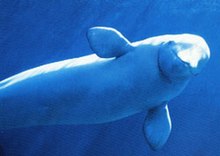| Monodontidae Temporal range:
| |
|---|---|

| |
| Beluga whale | |
|
Scientific classification
| |
| Domain: | Eukaryota |
| Kingdom: | Animalia |
| Phylum: | Chordata |
| Class: | Mammalia |
| Order: | Artiodactyla |
| Infraorder: | Cetacea |
| Superfamily: | Delphinoidea |
| Family: |
Monodontidae J. E. Gray, 1821 |
| Type genus | |
|
Monodon
C. Linnaeus, 1758
| |
| Extant genera | |
The cetacean family Monodontidae comprises two living whale species, the narwhal and the beluga whale and at least four extinct species, known from the fossil record. Beluga and Narwhal are native to coastal regions and pack ice around the Arctic Ocean. Both species are relatively small whales, between three and five metres in length, with a forehead melon, and a short or absent snout. Premaxillary teeth are absent. [1] They do not have a true dorsal fin, but do have a narrow ridge running along the back, which is much more pronounced in the narwhal. They are highly vocal animals, communicating with a wide range of sounds. Like other whales, they also use echolocation to navigate. [2] Belugas can be found in the far north of the Atlantic and Pacific Oceans; the distribution of narwhals is restricted to the Arctic and Atlantic Oceans.
Monodontids have a wide-ranging carnivorous diet, feeding on fish, molluscs, and small crustaceans. They have reduced teeth, with the beluga having numerous simple teeth, and the narwhal having only two teeth, one of which forms the tusks in males. Gestation lasts 14–15 months in both species, and almost always results in a single calf. The young are not weaned for a full two years, and do not reach sexual maturity until they are five to eight years of age. Family groups travel as part of herds, or 'pods', which may contain several hundred individuals. [2]
Taxonomy

The monodontids, oceanic dolphins (Delphinidae) and porpoises (Phocoenidae) together comprise the Delphinoidea superfamily. Genetic evidence suggests the porpoises are more closely related to the white whales, and these two families constitute a separate clade which diverged from the Delphinidae within the past 11 million years. [3] [4]
- Suborder
Odontoceti
- Superfamily
Delphinoidea
- Family Monodontidae
- Genus †
Haborodelphis
- Haborodelphis japonicus
- Genus †
Denebola
- Denebola brachycephala
- Genus †
Haborodelphis
- Subfamily
Delphinapterinae
- Genus
Delphinapterus
- Delphinapterus leucas, beluga
- Genus †
Casatia
- Casatia thermophila
- Genus
Delphinapterus
- Subfamily Monodontinae
- Family Monodontidae
- Superfamily
Delphinoidea
References
- ^ Bohaskaia monodontoides, a New Monodontid (Cetacea, Odontoceti, Delphinoidea) from the Pliocene of the Western North Atlantic Ocean
- ^ a b Brodie, Paul (1984). Macdonald, D. (ed.). The Encyclopedia of Mammals. New York: Facts on File. pp. 200–203. ISBN 978-0-87196-871-5.
- ^ Waddell, V.G.; Milinkovitch, M.C.; Bérubé, M. & Stanhope, M.J. (2000). "Molecular Phylogenetic Examination of the Delphinoidea Trichotomy: Congruent Evidence from Three Nuclear Loci Indicates That Porpoises (Phocoenidae) Share a More Recent Common Ancestry with White Whales (Monodontidae) Than They Do with True Dolphins (Delphinidae)". Molecular Phylogenetics and Evolution. 15 (2): 314–318. doi: 10.1006/mpev.1999.0751. PMID 10837160.
- ^ Bianucci; Pesci; Collareta & Tinelli (2019). "A new Monodontidae (Cetacea, Delphinoidea) from the lower Pliocene of Italy supports a warm-water origin for narwhals and white whales". Journal of Vertebrate Paleontology. 39 (3): e1645148. Bibcode: 2019JVPal..39E5148B. doi: 10.1080/02724634.2019.1645148. hdl: 11568/1022436. S2CID 202018525.
- ^ Jorge Vélez-Juarbe & Nicholas D. Pyenson (2012). "Bohaskaia monodontoides, a new monodontid (Cetacea, Odontoceti, Delphinoidea) from the Pliocene of the western North Atlantic Ocean". Journal of Vertebrate Paleontology. 32 (2): 476–484. Bibcode: 2012JVPal..32..476V. doi: 10.1080/02724634.2012.641705. S2CID 55606151.
External links
-
 Media related to
Monodontidae at Wikimedia Commons
Media related to
Monodontidae at Wikimedia Commons -
 Data related to
Monodontidae at Wikispecies
Data related to
Monodontidae at Wikispecies